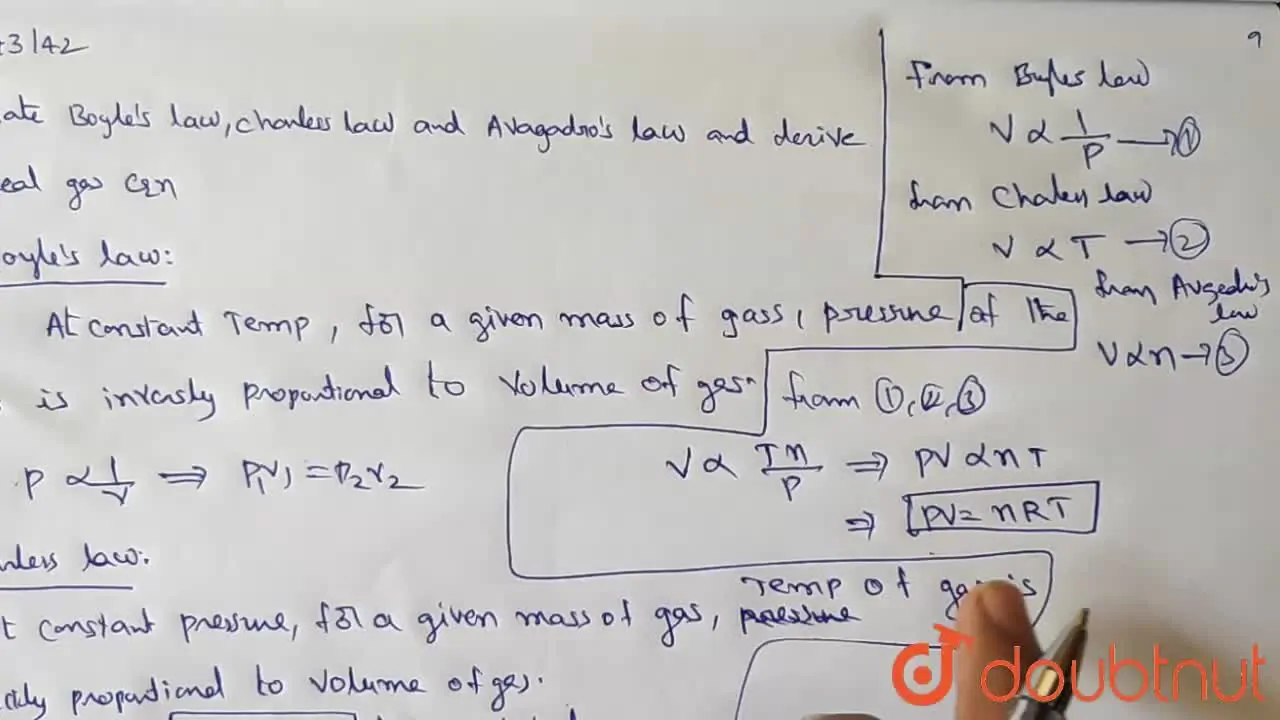State Boyle's law, Charles' law and Avogadro's law and derive ideal gas equation.Solution in Telugu
Boyle.s law : At constant temperature, the volume of a given mass of gas is inversely proportional to pressure of the gas.
V is the volume of a given mass of the gas and .P. its pressure, then the law can be written as
V∝1P at constant temperature
V=kp
∴PV=K
or P1V1=P2V2=K
Boyle.s law may also be stated as, .at constant temperature the product of the pressure and volume of a given mass of gas is constant."
Charles. law : At constant pressure, the volume of a given mass of gas is directly proportional to absolute temperature.
V∝T at constant pressure
V=KT
VT=k
Where V is the volume and T is the absolute temperature. V1andV2 are the initial and final volumes of a given mass of the gas at the absolute temperatures T1andT2 respectively at constant pressure.
V1T1=K,T2T2=K
orV1T1=V2T2=K
Avogadro.s law : Equal volumes of all gases contain equal number of moles at constant temperature and pressure.
V∝n (pressure and temperature are constant).
Ideal gas equation : The combination of the above gas laws leads to the development of an equation which relates to the four parameters volume, pressure, absolute temperature and number of moles. This equation is known as ideal gas equation.
In this Boyle.s law and Charles. law combined together and an equation obtained called the gas equation.
V∝1P (Boyle.s law)
V∝T (Charles law)
V∝n (Avogadro.s law)
Combining above three laws, we can write
V∝1P∝T∝n(or)V=R×1P×T×n
(or)PV=nRT
Where V = volume of the gas
P= pressure of the gas
n = no. of moles of gas
T = absolute temperature
R - Universal gas constant
Related Playlists
- BOOK - VIKRAM PUBLICATION ( ANDHRA PUBLICATION)CHAPTER - STATES OF MATTER GASES AND LIQUIDS EXERCISE - SHORT ANSWER QUESTIONS26videos
STATES OF MATTER GASES AND LIQUIDS
- BOOK - VIKRAM PUBLICATION ( ANDHRA PUBLICATION)CHAPTER - ORGANIC CHEMISTRY SOME BASIC PRINCIPLES AND TECHNIQUES EXERCISE - IMPORTANT QUESTIONS42videos
ORGANIC CHEMISTRY SOME BASIC PRINCIPLES AND TECHNIQUES
- BOOK - VIKRAM PUBLICATION ( ANDHRA PUBLICATION)CHAPTER - STOICHIOMETRY EXERCISE - Important Question39videos
STOICHIOMETRY
Similar Questions
State and explain Boyle's law.
06:51View SolutionWrite the regents required for conversion of benzene to methyl benzene.
02:50View SolutionHow many number of moles of glucose are present in 540 gms of glucose ?
View SolutionA gas that follos Boyle's law, charle's law and Avogadro's law is called an ideal gas. Under what conditions a real gas would behave ideally ?
05:02View SolutionState Boyle's and Charles' laws.
01:36View SolutionState Boyle's law. Derive it on the basis of the kinetic theory of an ideal gas.
02:20View SolutionState Boyle's law, Charles' law and Avogadro's law and derive ideal gas equation.
02:39View SolutionState Boyle's law and Charles law.
02:33View SolutionObtain an ideal gas law from Boyle's and Charles' law.
02:42View SolutionState and explain Boyle's law and Charles' law. Derive gas equation from these laws.
03:25View SolutionA gas that follos Boyle's law, charle's law and Avogadro's law is called an ideal gas. Under what conditions a real gas would behave ideally ?
08:40View SolutionA gas that follows Boyle's law, Charle's law and Avogadro's law is called an ideal gas. Under what conditions a real gas would behave ideally ?
View SolutionState and explain boyle's and Charles's law. Derive gas equation from these laws.
View SolutionDeduce and explain Boyle's law and Charles' law on the basis of kinetic gas equation.
03:53View SolutionState Boyle's law and Charle's law. Hence, derive ideal gas equation. Which of the two laws is better for the purpose of thermometry and why ?
05:02View Solution


